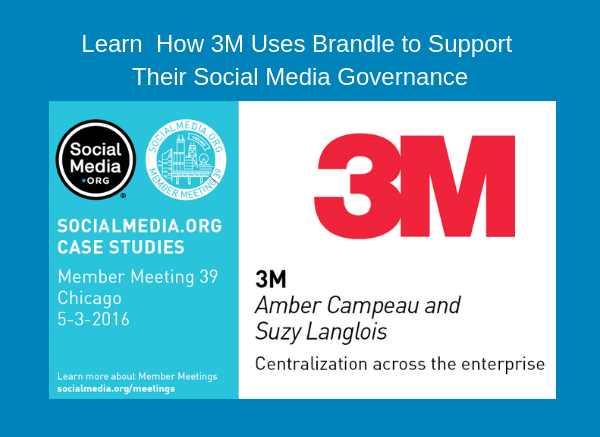 At this stage of the social game, most companies (of all sizes) have their arms around using social media as part of their brand marketing strategy and community development. But moving your company into operating as a true Social Business is a game changer! Strong brand presence management is required in order to scale your organization, protect your intellectual property, strengthen your security measures, and reduce liability risks. And you need to care about it!
At this stage of the social game, most companies (of all sizes) have their arms around using social media as part of their brand marketing strategy and community development. But moving your company into operating as a true Social Business is a game changer! Strong brand presence management is required in order to scale your organization, protect your intellectual property, strengthen your security measures, and reduce liability risks. And you need to care about it!
Instead of social operating solely in the marketing or communications organization, it becomes critical to include all business units and operational units (such as HR, IT and Legal). Plus it becomes critical to consider how you will keep communication and workflow clear between departments in order to transform your business.
If you are unsure about where you’re company is along the Social Business transformation continuum, review the The Evolution of Social Business by the Altimeter Group. This will help you to know where you need to go and how you might want to get there.
To understand the value of transforming into a Social Business, there have been a number of excellent reports, including McKinsey’s The Social Economy: Unlocking Value and Productivity through Social Technologies and MIT Sloan/Deloitte collaboration Social Business: What are Companies Really Doing?
Here are the key ingredients to get you started on sound brand presence management:
Manage Your Points of Presence (POPs)
If you’re like most companies, you probably already keep an inventory of your branded web properties in a spreadsheet. Even if you are a master at spreadsheet jujitsu, it is a challenging and tedious task to keep a spreadsheet up to date and accurate. What if someone changes credentials and forgets to record it on the spreadsheet? That’s why we created the Brandle System. As your social workforce grows, we believe having a centralized and automated inventory system will be vital to scale the business.
But whether you choose to manage with a central system or with a spreadsheet, you need to ensure you're tracking all the necessary elements. It can get unwieldy, so here are the basics:
- Name of account, page, channel, board, etc.
- The URL
- Who has admin rights
- Credentials to access
- Official avatar
- Employees with access
- Agency or consultants with access
Audit Your POPs
You also need to have a plan to audit these points of presence and to audit the web for anything that may look like your brand. This WSJ article highlights a recent report by Protiviti showing that most companies are challenged in this area.
Your plan should be specific for your company and industry. If you have a high value luxury brand, in an industry that has fraudulent activity (let’s say luxury handbags), then your audit program should probably be more frequent and diligent. You will want to have your legal counsel tightly connected to your workflow so you can clearly communicate how the infringement is being addressed and how you will view or search for that specific infringement in future audits.
A consistent audit program that fits your company’s needs enables you to know your inventory is accurate, to protect your trademark(s) and IP, and to protect your customers from inauthentic sites.
Clarify Ownership of POPs. They are Corporate Assets.
It seems obvious that if a brand has created a Facebook page (or any other social presence) that focuses on a brand or campaign, that the company owns that presence, the content and the community around it. But there have been some cases where the “bright line” of ownership is not so clear.
In the article, Who Owns Your Social Media Account and Followers When your Employee Leaves?, Mr Machado emphasizes the importance of clarifying with one’s employees that the company owns all of these assets. For many social businesses, this is not necessarily the right (or even appropriate) policy. If you are expanding your social reach and empowering your employees to “Bring Your Own Social”, then the policy needs to reflect two types of ownership: what the company owns and what the employee owns. You need to cover this in your social media policy and in all contracts where agencies or consultants have access to web properties to work on the companies behalf. Be specific about ownership and consider how you will be transforming your company's social workforce.
We believe that these POPs are so critical to your business that it’s time you begin to think of them as true corporate assets, that have significant value for the company.
Educate Employees
Most companies have a Social Media Policy that outlines how to behave on social media, how to use (or not use) logos to protect IP, and hopefully, an ownership statement. What many companies forget to do is have a policy review and update schedule where employees are trained and refreshed. This is an important step as you scale your Social Business. If done successfully, it will become an automatic process within your communication workflow. For a Social Business to be successful, the "social" needs to be ingrained in the corporate culture.
Practice Strong Security
Your IT department will have good suggestions on security practices such as changing passwords often (create a schedule so you don’t forget) and making those passwords challenging. You will also want to limit access appropriately to ensure the number of avenues to compromise your POPs are few. This is helpful to prevent situations such as the Burger King and Jeep hackings.
Monitoring your accounts for any other changes such as product statements and avatar changes are also important. Unplanned changes can be a risk to your brand positioning (at least) and at most an early sign that you’re account is being mismanaged or hacked.
With strong planning and focus, you can create a scaleable brand presence management solution for your company. This practice is sometimes called Social Media Governance. And even though we are talking about a level of control when we say “governance”, don’t forget that Social Business is all about building and maintaining relationships! You may need to carry the flag and be the designated “change-agent”, but the transformation will be rewarding for the business, and for you.








